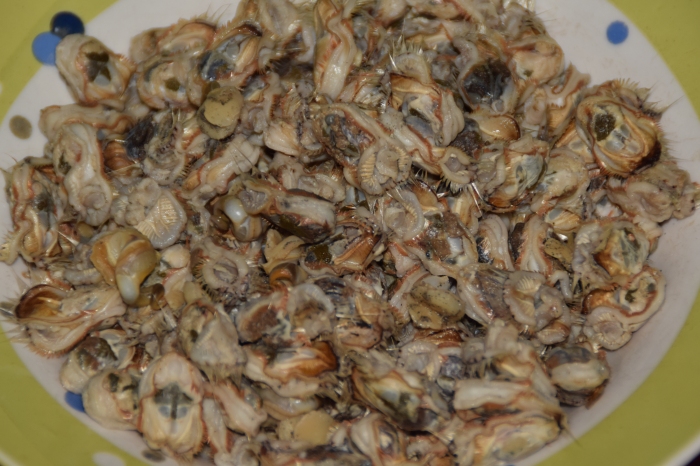
In a previous article, this writer made a commitment to do another one that traces the steps of something that began as the “ugpan” shellfish in Manong Boning‘s basket, and ended up on an empty plate [picture above] that’s due for the dishwasher. This is it.
Having been dug from the intertidal mudflats of Barangay Manipis in Tanjay City, our subject “ugpan” shellfish is of course covered in some mud – that’s actually a mixture of silt and sand. Thus, anyone intent on consuming them should be prudent enough to consider washing them first.

The “ugpan” shellfish has essentially two parts. The tail part – a white-colored cartilaginous tube-like appendage that’s attached to the body or the shell itself. It can be eaten raw. Just dip it in vinegar, dunk it in the mouth, and whallahh.. but that’s something right there that passes for a bizarre food. So, if you’re not as inclined to such kinds of foods as Andrew Zimmern or this writer, then you can forget it. After all, this article is not about eating the “ugpan’s” tail.

This brings us now to the shell part, composed of the shell and the meat inside. At this point, what we’re after is the meat, so we take a cauldron, or any similar kitchen equipment, and put in it about two to three liters of water. Place it on the fire or a lit stove, and wait till the water begin to boil. Once the bubbles start rising to the surface, it’s time to put in the shells, and let it boil for about five minutes. That should be enough for the shells to open, allowing for the easy extraction of the meat inside. Drain the water, but don’t throw it away; just put it in another container and set aside for later. After the shells have cooled enough, extract the meat and also set aside.

Now for the other ingredients. For about a kilo of “ugpan” shellfish [including the tails, shells, the mud], like what we’re working on here, we need about a kilo of plump red tomatoes, one piece of onion, about five cloves of garlic, twenty pieces of chinese mugwort leaves [optional, locally it’s hilbas], and 500 grams of pasta of your choice [to be cooked separately].
Chop everything. The tomatoes, the onion, garlic, and the mugworts, putting them on separate containers. Then we make the sauce. Put your average-sized wok on a medium fire setting, add a little cooking oil [olive oil, if you’re not a budget], heat it up a bit and then drop in the spices.

Once the spices get brown a bit, we put in the “ugpan” meat, and we stir. Now, remember the water in which we boil the shellfish, and set aside earlier? Take about a cup or two of that and put it in the mix.

After about five minutes, we dump the tomatoes in, and add about three more cups of our shellfish broth.

Then we let it simmer for about fifteen minutes, to reduce the tomatoes to a sauce, adding some broth in order to adjust the texture, and some salt and msg to attain the desired taste.

Once our sauce is done, we now get ready to mate it with the pasta that we’ve cooked separately.


And now we’ve come full circle.. to the image at the top of this article. An empty plate, and a full stomach. If you like this, please help save the Tañon Strait.
-shortstab